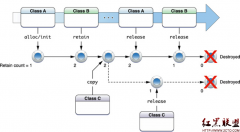当C++遇到IOS应用开发---LRUCache缓存(2)
if (lock->write) {//当已是写锁时,则去掉读锁记数器
__sync_sub_and_fetch(&lock->read,1);
} else {
break;
}
}
}
static inline void
rwlock_wlock(struct rwlock *lock) {
__sync_lock_test_and_set(&lock->write,1);
while(lock->read) {
//http://blog.itmem.com/?m=201204
//http://gcc.gnu.org/onlinedocs/gcc-4.6.2/gcc/Atomic-Builtins.html
__sync_synchronize();//很重要,如果去掉,g++ -O3 优化编译后的生成的程序会产生死锁
}
}
static inline void
rwlock_wunlock(struct rwlock *lock) {
__sync_lock_release(&lock->write);
}
static inline void
rwlock_runlock(struct rwlock *lock) {
__sync_sub_and_fetch(&lock->read,1);
}
这里并未使用pthread_mutex_t来设计锁,而是使用了__sync_fetch_and_add指令体系, 当然最终是否如上面链接中作者所说的比pthread_mutex_t性能要高7-8倍,我没测试过,感兴趣的朋友也可以帮助测试一下。
有了这两个类之后,我又补充了原文作者中所提到了KEY比较方法的定义,同时引入了id来支持object-c的对象缓存,最终代码修改如下:
[cpp]
#ifndef _MAP_LRU_CACHE_H_
#define _MAP_LRU_CACHE_H_
#include <string.h>
#include <iostream>
#include "rwlock.h"
#include <stdio.h>
#include <sys/malloc.h>
using namespace std;
namespace lru_cache {
static const int DEF_CAPACITY = 100000;//默认缓存记录数
typedef unsigned long long virtual_time;
typedef struct _HashKey
{
NSString* key;
}HashKey;
typedef struct _HashValue
{
id value_;
virtual_time access_;
}HashValue;
//仅针对HashKey比较器
template <class key_t>
struct hashkey_compare{
bool operator()(key_t x, key_t y) const{
return x < y;
}
};
相关新闻>>
- 发表评论
-
- 最新评论 进入详细评论页>>








![[iPhone中级]iPhone团购信息客户端的开发 (二)](/uploads/allimg/131022/200H11235-0-lp.png)

